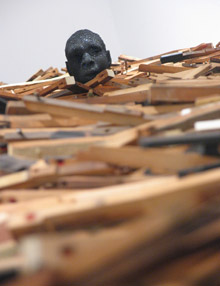
WINDWARD COAST Radcliffe Bailey's installation sweeps you up with its use of material, epic scale, and haunting vision. |
From a distance Radcliffe Bailey's 2009 installation Windward Coast looks like a rolling ocean of big, burned matches, or maybe straw. And at one end, lost at sea, bobs a man's head, charcoal black and glittering like a starry midnight sky. The man's eyes squint closed, as if in a stupor— or perhaps we're witnessing his dream.
>> SLIDESHOW: "Memory as Medicine" + "Six Artists from Cairo" <<
Windward Coast is far and away the best piece in Bailey's 35-work survey "Memory as Medicine," organized by Atlanta's High Museum of Art and on view through May 6 at Wellesley College's Davis Museum (106 Central Street, Wellesley).
The title refers to the West African coast from which people were shipped across the Atlantic to slavery in the Americas. So the head might be a slave who was cast overboard, or one who leapt. Up close, it becomes clear that the 20-foot-wide sea is thousands of old piano keys (salvaged from some 400 pianos at a piano restorer near the Atlanta artist's home). So he's drowning in or buoyed by waves of music? Or broken music? The sound of the disengaged keys clattering to the floor broadcasts from a conch shell mounted in the corner of the room. The symbols begin to conflict rather than cohere, but the installation sweeps you up because of Bailey's knack for materials (old piano parts, glitter), epic scale, and haunting vision.
The rest of the show — mainly lyrical paintings incorporating palm motifs, vintage photos of black folks, collaged images of traditional African sculptures, and charismatic found objects (boat models, top hats, a lantern) — isn't as mysterious or charged. Bailey's web of references (the African diaspora, Kongo cosmograms, Yoruban gods, the Middle Passage, blues, jazz) is compelling, but these subjects are often obscured in the art. The works could be about resolving the past. Everything is sort of groovy, propelled by Bailey's handsome touch for paint, glitter, wax, and assemblages of curious stuff. He's best at installations.
Minor Keys (2005) features plastic toy planets and an old door key labeled like specimens and pinned to disengaged piano keys coated with lumpy black wax; they cascade down the gutted belly of a baby grand piano mounted vertically on a wall. It's an homage to Sun Ra, and the comparison of the two artists is revealing. The jazz legend was far out, experimental, challenging, mind blowing, whereas Bailey is polished, predictable, sweet, polite.
"Histories of Now: Six Artists from Cairo" at the School of the Museum of Fine Arts (230 the Fenway, Boston, through March 17) rounds up six contemporary Egyptian video artists for a snapshot of what Egyptians have been thinking lately. The group fits in the international, smartypants, conceptual mode that probably works well for avoiding trouble with repressive regimes because the coded postmodernism obscures much of its social critique.